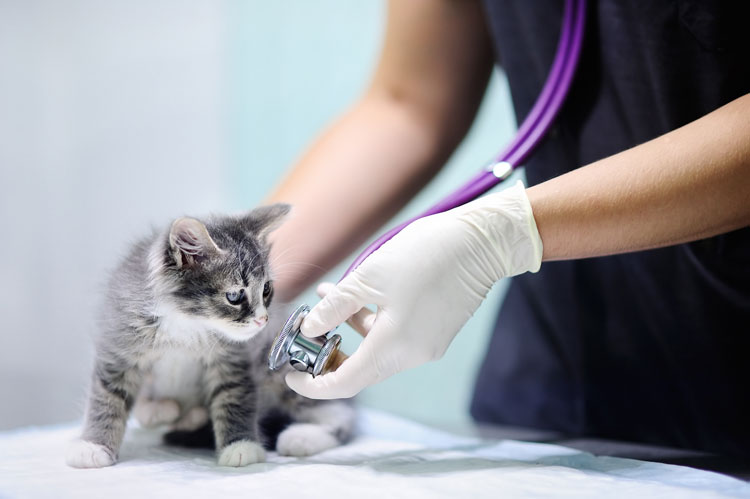By Julie Liu, DVM
Years ago, I would routinely walk into the doctors’ office in the morning to see one of the other vets typing away with the overhead light turned off. The exterior wall to the office was a large window that faced east so there was always some early morning light, but still, I didn’t get it. Wasn’t it always better to have more light? Why toil away in the dark like a cave creature? After a while, I started getting used to only having natural light in the office, and noticed that I felt a lot calmer. If another doctor turned the light on, it felt way too bright and jarring. I realized that something as simple as decreasing the intensity of the light in my environment could magically decrease my stress without me even noticing.
When it comes to our feline patients, many of the surroundings in a vet hospital can be similarly disruptive, and may even lead to fear, anxiety, and stress (FAS). By reimagining the environment and catering to the feline senses, we can promote relaxation for both cats and humans. Here are some simple, budget-friendly tips for creating Fear Free feline exam rooms.
Provide a Safe Place
In 2022, the AAFP/ ISFM updated their guidelines for a Cat Friendly Veterinary Environment, in which they reference the 5 Pillars of a Healthy Feline Environment. Pillar 1, “Provide a Safe Place”, is paramount. So what makes cats feel safe?
When cats are experiencing FAS, hiding becomes a major way in which they cope. Think of all those cats you’ve seen hiding behind the computer screen in the exam room-–they’re trying to cope with the stress of being in a scary place. Ensuring that every exam room is stocked with towels will facilitate hiding and comfort during the visit. You can even go next level and get a towel warmer. The thermoneutral zone for cats is 86-100.4℉, and warm bedding is so much cozier.
Cats also feel safer when they can be elevated. Non-slip cat perches and cubby holes mounted onto the wall will let them survey the room from a height. Just make sure that any cubby can be opened easily to access the cat, as removing them from their “safe” place will increase FAS. Similarly, if budget allows, replace exam room chairs with a bench that extends to the floor so cats don’t have to be pulled out from their hiding spot.
Instead of taking cats to the noisy and stressful treatment area for samples, treat each exam room like a private, “safe” treatment area for that kitty and stock it appropriately: tubes, syringes, smaller gauge needles, butterfly catheters, slides, and EMLA cream to reduce the pain of needle pokes. If team members aren’t comfortable collecting samples in front of the owner, most clients are more than willing to hang out in the waiting area until you’re done.
Considerate Approach
When we use Fear Free Considerate Approach, we want to consider how our felines are experiencing their environment during care.
- Touch. Exam tables are slippery and cold, so ensure all tables have a non-slip surface like a yoga mat to act as a base under your warm towel. Every room should also have a non-tippable cat scale with a stable surface, which could be a Feliway-sprayed towel that you “tare” prior to weighing the cat.
- Taste. While many cats will be too fearful to eat treats, others can readily be distracted by Temptations, Churu, squeeze cheese, tuna, turkey baby food, and other snacks during interactions. Also be mindful of taste the next time you’re dousing cats with alcohol to collect samples–unless you wipe the alcohol off with a damp washcloth, you’re contributing to a negative experience when they groom themselves after the visit.
- Visual. Photorealistic depictions of cats or other animals may cause cats to react, so abstract art often works best. If you’re lucky enough to have a quiet exam room with a window, consider making that a feline-only room. Many cats will explore the room and gaze outside during a visit, which works great as a distractor. Cats are also better able to see in lower light than people, so install a dimmer switch to decrease light intensity.
- Auditory. Noise can significantly increase a cat’s FAS, and should be minimized wherever possible. Installing soft closers on cabinets/ doors and hanging a “Shhh….feline appointment in progress!” sign on the treatment area side of the door will remind team members to use their inside voices and keep environmental sounds low. You can also hook a speaker up to the computer and play soft, cat-specific music. A 2019 study published by the Journal of Feline Medicine and Surgery found that cats listening to cat-specific music in a veterinary clinical setting had lower cat stress scores and lower mean handling scale scores than cats that were exposed to silence or classical music.
- Olfactory. Pets leave behind lots of scents during visits, and smelling them may increase FAS, particularly if a dog was just in that room. Having a cat-only exam room decreases olfactory stressors, and Rescue will allow you to disinfect and remove traces of the previous patient while minimizing harsh smells from scented cleaners.
- Pheromonal. When your cat rubs their cheek against your leg or the furniture, they’re depositing the feline facial pheromone that marks an area as “safe”. Feliway Classic mimics this pheromone, and comes in diffusers that can be plugged into every exam room. You can also pre-spritz room towels with Feliway spray at least 15 minutes before the first appointment, then reload for afternoon kitties since it wears off in 4-5 hours. Don’t forget to label your diffuser with some client ed so cat parents see the Fear Free value.
The exam room can be a scary place for many cats, causing them to experience FAS even before handling. Adding some Fear Free tools and considering the feline senses will help turn your exam rooms into kitty havens.
Resources
https://fearfreepets.com/top-10-treats/
https://fearfreepets.com/helping-our-feline-friends-feel-fear-free-with-dr-tony-buffington/
https://fearfreepets.com/providing-the-optimum-environment-for-cats/
https://fearfreepets.com/creating-a-comfortable-environment-in-the-clinic/
JFMS: https://journals.sagepub.com/doi/full/10.1177/1098612X221128763
JFMS: https://journals.sagepub.com/doi/10.1177/1098612X19828131
Cat music: https://www.youtube.com/watch?v=vGyElqvALbY






